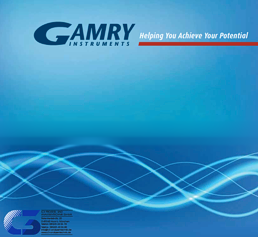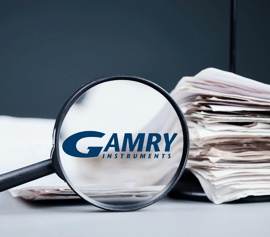POTENTIOSTAT / GALVANOSTAT
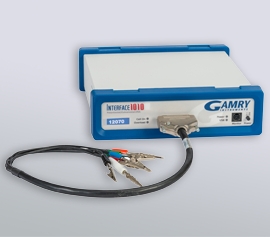
The Interface 1010 is a value oriented, general purpose potentiostat for almost all applications except for high current electrochemistry.
The "T(eaching)" version of the Interface 1010 can be purchased flexibly at a low entry level budget for almost all applications in electrochemical research and -industry. Later, if requirements increase, existing electronic components with higher specifications can be activated by means of a paid upgrade.
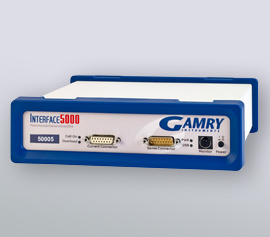
The Interface 5000 Potentiostat / Galvanostat / ZRA is a compact, inexpensive system for material development and condition testing of batteries, super capacitors and fuel cells
The Interface 5000 delivers a higher current of ± 5A in direct comparison with the Interface 1010. The maximum available working electrode potential is ± 6V. The additional electrometer allows the simultaneous tracking of both half cells of a battery, a supercapacitor or a fuel cell when using an embedded reference electrode including the whole cell in a single experiment. Due to this time saving additional experiments can be scheduled.
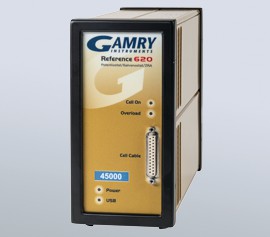
The latest development in the Reference 600 series - the Reference 620 - features 20-bit analog/digital conversion, gaining about a decade of additional sensitivity. This makes the system the first choice for demanding applications, e.g. in basic research.
The Reference 620 offers eleven current ranges between 60 pA - 600 mA at a maximum of ± 12 V at the working electrode. Two additional gain stages (10x / 100x) extend to an even broader current range of 13 decades, allowing electrochemical impedance spectroscopy (EIS) on very high ohmic surrogates between 5 MHz and 10 µHz with current resolutions down to 20 aA per bit using state-of-the-art microelectronics and oversampling. Careful selection of electronic components and design result in...
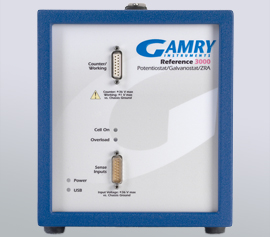
The high-end potentiostat for all demanding applications in electrochemistry from very low to high currents.
The Reference 3000 offers eleven current ranges between 300 pA - 3000 mA at a maximum of either ±3A@±15V or ±1.5A@±32V at the working electrode. Two additional gain stages (10x / 100x) extend to an even broader current range of 13 decades, allowing electrochemical impedance spectroscopy (EIS) on very high ohmic surrogates between 1 MHz and 10 µHz with current resolutions down to 100 aA per bit using state-of-the-art microelectronics and oversampling. Careful selection of electronic components and design result...
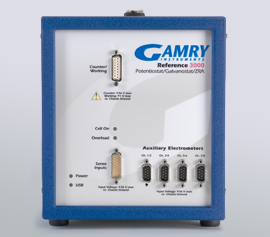
The well-known high-end Reference 3000AE Potentiostat/Galvanostat/ZRA with eight additional auxiliary electrometers (AE).
With the eight additional channels of the Auxiliary Electrometer (AE) add-on option of the Reference 3000 Potentiostat / Galvanostat / ZRA, potential differences of either eight individual half cells of a stack or up to eight peripherical signal transducers can be measured. Each of the eight available electrometers (± 5 V vs. counter electrode potential) can clarify the impedance of a half cell in an electrochemical impedance spectroscopy measurement performed over the entire stack or to simply measure eight additional...
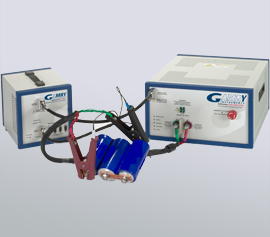
The Reference 3000 (AE) Potentiostat/Galvanostat/ZRA high performance and multi-purpose basic unit can be combined with the Reference 30k Booster and is ideal for evaluating new highest-level technologies for batteries, fuel cells, supercapacitors and high turnover electrochemical synthesis.
The Reference 3000 is already a high-performance system, but with the addition of the Reference 30k booster, it can serve even more demanding applications. You can therefore make a valuable contribution at the highest level in basic research, electrochemical synthesis, and electrochemical energy storage. The Reference 3000 basic instrument can either be equipped later with 8 additional auxiliary electrometers (AE; Auxilliary Electrometer) by means of a hardware upgrade, or you can opt for the Reference 3000AE.
HIGH-POWER POTENTIOSTATS
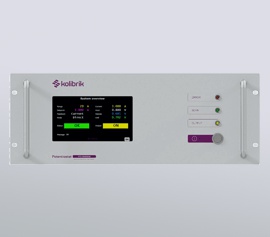
The PTC series is used for measurements with high current requirements, e.g. for the characterisation of electrolysers or fuel cells
The 4-quadrant potentiostats/galvanostats of the PTC series are available with four power ranges up to max. ±100A@±5V. Impedance spectroscopy (EIS) is possible via two channels between 1 mHz and 100 kHz. This means that tasks in general electrochemical synthesis, from water splitting and alkaline CO2 conversion to fuel cells and other energy storage and conversion concepts, can also be successfully mastered on larger surfaces with higher material conversion and higher current requirements.
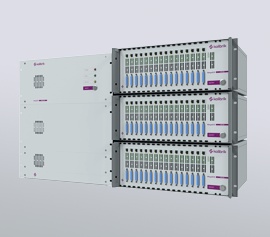
Modular configurable multi-channel (up to 1000 individual cells) impedance test stand for fuel cell and electrolysis cell stacks as well as Li-ion and redox flow battery packs
The MegaEIS multi-channel electrometer/impedance spectroscopy test stand enables the characterisation and optimisation of up to 1000 individual cells, e.g. of a fuel cell or electrolysis cell stack up to 1000 V / 2000 A within a power limit of 250 kW. For tasks in general electrochemical synthesis from water splitting and alkaline CO2 conversion to fuel cells and other energy storage and conversion concepts - also on an industrial scale.
POTENTIOSTAT - MULTI-CHANNEL SYSTEMS
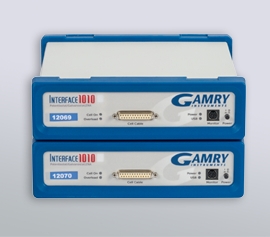
The Interface 1010 Bipotentiostat System from Gamry is compact, flexible, and inexpensive for all kinds of electrochemical measurements using two channels.
Each channel of the Interface 1010 bipotentiostat with its eleven current ranges including 10x / 100x gain record currents from 100 pA to 1 A at ± 12 V working electrode potential. The Interface 1010 Bipotentiostat is shipped including a special cable for synchronization. Since the systems are floating from protective ground, synchronous operation without mutual interference is possible.
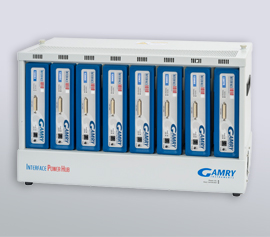
Multi-channel systems are ideal for any application where significance can be increased by higher experimental throughput.
With the multi-channel potentiostat from Gamry, a single system can be flexibly configured from many channels for research purposes with high significance. Flexibility means to operate each channel individually, in groups or all together. Each channel covers either a current range from 100 pA to 1 A (IFC1010) or from 500 nA to 5 A (IFC5000) and can maintain a maximum potential of either ± 12V (IFC1010) or ± 6V (IFC5000) at the working electrode.
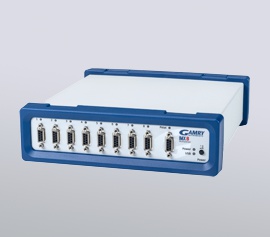
The IMX8 (Electrochemical Multiplexer) offers higher experimental throughput by performing automatic sequential measurements. With some limitations compared to multi-channel systems is a cost effective alternative for many applications.
With the IMX8, the throughput of electrochemical experiments in the laboratory can be increased from one channel to a total of eight channels within a reasonable budget. The ECM8 is the ideal additional system for the application field of corrosion inhibitor development, corrosion testing methods and their field tests, assessment of the impedance of coatings and development of chemical sensors.
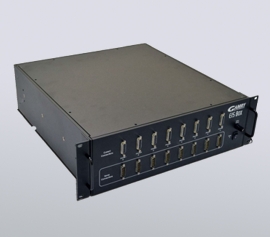
The Gamry EIS Box 1010 consists of an Interface 1010 base unit and an electrochemical multiplexer optimized for impedance spectroscopy (EIS) on batteries, fuel cells and super capacitors up to ±12 V.
With the EIS Box 1010, the detailed characterization of multiple batteries using the sophisticated method of electrochemical impedance spectroscopy (EIS) is intuitively possible and at the same time offers reliable results at high throughput. This efficiently accelerates tasks in quality assurance, material development and basic research of electrochemical energy storage devices.

The Gamry EIS Box 5000 consists of an Interface 5000 base unit and an electrochemical multiplexer optimized for impedance spectroscopy (EIS) on batteries, fuel cells and super capacitors up to ±6 V.
With the EIS Box 5000, the detailed characterization of multiple batteries using the sophisticated method of electrochemical impedance spectroscopy (EIS) is intuitively possible and at the same time offers reliable results at high throughput. This efficiently accelerates tasks in quality assurance, material development and basic research of electrochemical energy storage devices.
SOFTWARE

Gamry has developed its own software for each important application in electrochemistry and offers a very simple and intuitive handling through open source scripting, flexible and uncomplicated, even the customized experiment as well as with other programming languages such as LabView, C++, etc.
In a Gamry system, the electrochemical experiment consists of two separate operations, each in its own software environment. The recording of the measured data is done with modifiable scripts programmed in "Explain" in the Gamry Framework and their evaluation with modifiable Microsoft Visual Basic for Applications (VBA) scripts in the Echem Analyst.
GAMRY ACCESSORIES FOR ELECTROCHEMISTRY
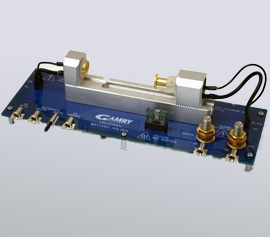
The all-rounder among battery holders - designed for cylindrical 18650 cells as well as button cells - with high flexibility in dimensions and connection options
With the Universal Battery Holder (UBH) a variety of batteries can be connected to all available Gamry Instruments systems - from Interface 1010 to Reference 3000 (AE) including Reference 30k Booster - with a true “four-terminal Kelvin-type” contact, cycled up to 30A and characterized in terms of their impedance.
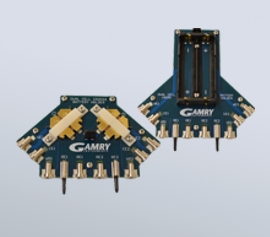
For electrochemical impedance spectroscopy on the coin cell types CR2016, CR2025 and CR2032 or on the cylindrical 18650 cell
Gamry´s Low Inductivity Battery Holder for cylindrical cells (18650) and coin cells (CR2016, CR2025 and CR2032) can reduce unwanted impedances due to the cable connection and contact impedances to a minimum thanks to the four-terminal Kelvin-type gold-plated contacts. The leads on the printed circuit board also ensure reduced inductive crosstalk with about 500 pH to 5 nH.
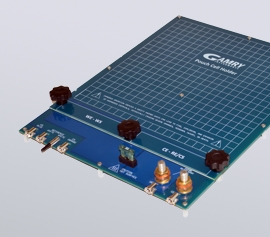
Flexible battery holder for pouch cells to characterize different types of pouch cells with different dimensions
With the Pouch Cell Holder a variety of pouch cell types can be connected to all available Gamry Instruments systems for reproducible and reliable measurement results with a true “four-terminal Kelvin-type” contact, cycled up to 30 A and characterized in terms of impedance.
ELECTROCHEMISTRY IN AN AUTOCLAVE
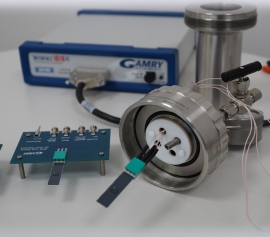
Electrochemical synthesis, the characterization of catalysts, corrosion measurements or basic research on new electroactive species can also be carried out at higher pressures and beyond room temperature with Gamry Instruments potentiostat in an autoclave from Büchi.
For any application in an autoclave, safety always comes first due to the enormous amount of stored energy at high pressure and temperature. Our autoclaves from Büchi Glas Uster are equipped with appropriate measuring and safety devices ex works. Thanks to the comprehensive selection of vessels, your experiment can always take place in the smallest possible volume. By means of pressure-tight cable feed-throughs, the contact between the samples and the potentiostat can be established without compromising on the temperature and...
